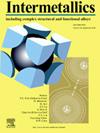Statistical analysis of lamellar and Widmannstätten structures obtained in Nb-rich γ-TiAl alloy with varied cooling rate and annealing duration
IF 4.3
2区 材料科学
Q2 CHEMISTRY, PHYSICAL
引用次数: 0
Abstract
Nb-rich γ-TiAl alloys are of interest for enhanced mechanical properties and oxidation resistance. The influence of cooling rate and annealing duration on microstructural evolution of Nb-rich γ-TiAl alloy (Ti-45Al-8Nb-0.2B) has been meticulously investigated, with emphasis on phase volume fraction, grain size, and lamellar spacing. The alloy was annealed at 1320 °C for 15 min, and then furnace-cooled, oil-quenched or cryogenic quenched, whereas annealing for 2 h and 26 h was followed by water quenching. The post-anneal microstructures were characterized using X-ray diffraction, optical and scanning electron microscopy, along with energy dispersive spectroscopy and electron backscattered diffraction. Across all samples, a fully lamellar microstructure comprising α2 and γ phases has been consistently achieved, along with sporadically observed small β precipitates, and elongated ribbon-like TiB2. Widmannstätten colonies (WC) have been observed with diverse morphologies, most of which exhibited an angle of around 64° to regular lamellae, supporting the theory of twinning in the α-phase for WC formation. The γ phase fraction has decreased with increasing cooling rate and annealing time. Grain size and lamellar spacing have also declined with cooling rate but increased with annealing time. Additionally, the mean size of equiaxed γ grains has enlarged with annealing duration.
不同冷却速率和退火持续时间下富铌 γ-TiAl 合金中获得的片状和 Widmannstätten 结构的统计分析
富含铌的 γ-TiAl 合金可提高机械性能和抗氧化性。我们仔细研究了冷却速度和退火持续时间对富铌 γ-TiAl 合金(Ti-45-Al-8Nb-0.2B)微观结构演变的影响,重点研究了相体积分数、晶粒尺寸和薄片间距。合金在 1320 °C 下退火 15 分钟,然后进行炉冷、油淬或低温淬火,退火 2 小时和 26 小时后进行水淬。使用 X 射线衍射、光学和扫描电子显微镜以及能量色散光谱和电子反向散射衍射对退火后的微观结构进行了表征。在所有样品中,始终可以看到由 α2 和 γ 相组成的完全片状微观结构,以及零星观察到的少量 β 沉淀和拉长的带状 TiB2。观察到的 Widmannstätten 菌落(WC)形态各异,其中大多数与规则薄片的夹角约为 64°,支持 WC 形成的α相中{1‾1‾22}孪晶理论。随着冷却速率和退火时间的增加,γ 相的比例有所下降。晶粒大小和薄片间距也随着冷却速率的增加而减小,但随着退火时间的增加而增大。此外,等轴γ晶粒的平均尺寸随着退火时间的延长而增大。
本文章由计算机程序翻译,如有差异,请以英文原文为准。
求助全文
约1分钟内获得全文
求助全文
来源期刊

Intermetallics
工程技术-材料科学:综合
CiteScore
7.80
自引率
9.10%
发文量
291
审稿时长
37 days
期刊介绍:
This journal is a platform for publishing innovative research and overviews for advancing our understanding of the structure, property, and functionality of complex metallic alloys, including intermetallics, metallic glasses, and high entropy alloys.
The journal reports the science and engineering of metallic materials in the following aspects:
Theories and experiments which address the relationship between property and structure in all length scales.
Physical modeling and numerical simulations which provide a comprehensive understanding of experimental observations.
Stimulated methodologies to characterize the structure and chemistry of materials that correlate the properties.
Technological applications resulting from the understanding of property-structure relationship in materials.
Novel and cutting-edge results warranting rapid communication.
The journal also publishes special issues on selected topics and overviews by invitation only.
 求助内容:
求助内容: 应助结果提醒方式:
应助结果提醒方式:


